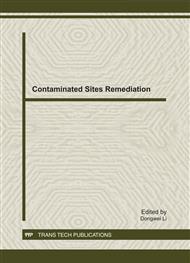[1]
Zhang X, Hua M, Huang Q.F. The current situation and development of cement kiln co-processing technology of solid waste. Recycling Research, 2007, (4): 37~40.
Google Scholar
[2]
Zhu X. M, Liu J. G, Huang Q.F. The application and limitation of cement kiln co-processing technology of solid waste. China Cement, (4) (2006) 45~49.
Google Scholar
[3]
Mokrzycki E., Uliasz B. A., Sarna M. Use of alternative fuels in the Polish cement industry. Applied Energy, 74(1) (2003) 101~ 111.
DOI: 10.1016/s0306-2619(02)00136-8
Google Scholar
[4]
Liao Q. Q, Yao S.Y. The analysis on pollution control of cement kiln disposal technology of urban sewage sludge. China Resources Comprehensive Utilization, 28(9) (2010) 48~50.
Google Scholar
[5]
Shi H.S. The research on cement kiln disposal technology of urban sewage sludge. Cement, (7) (2002) 8~10.
Google Scholar
[6]
Qiao L.S. The relevant problems of the usage of waste in cement plant (III): the pollution of harmful gas and radioactive. Cement, 29 (2002) 1~7.
Google Scholar
[7]
Guo H, Zhang H. Y, Qu G.X. The advantages of new-style precalcining cement kiln for the disposal of city liquid and solid waste. Henan Building Materials, (4) (2010) 87~93.
Google Scholar
[8]
Ma Y, Yu W.H. The analysis on cement kiln disposal technology of urban sewage sludge. Shanghai Building Materials, (1) (2000) 38~40.
Google Scholar
[9]
Hu Z.J. The harmless and recycle process of cement for kiln sludge. Cement, 2003, 4: 6~8.
Google Scholar
[10]
Yan D. H, Li L, Huang Q.F. Distribution of heavy metals during co-processing hazardous wastes in new dry cement kilns. China's Environmental, 29(9): (2009) 977~984.
Google Scholar
[11]
Qi Z. G, James O. Heavy metal outputs from a cement kiln co-fired with hazardous waste fuels. Journal of Hazardous Materials, 51(4) (1996) 47-65.
DOI: 10.1016/s0304-3894(96)01800-6
Google Scholar
[12]
Riganti V, Fiumara A, Odobez G B. The use of industrial sludges as raw materials in the cement industry. Waste Management and Research, (4) (1986) 293-302.
DOI: 10.1177/0734242x8600400135
Google Scholar
[13]
Juan A, Galvez A, Mateos F. Organic and inorganic pollutants from cement kiln stack feeding alternative fuels. Journal of Hazardous Materials, 116(1) (2008) 1-8.
DOI: 10.1016/j.jhazmat.2008.01.116
Google Scholar
[14]
Petkovic G, Engelsen C J, Breedveld G. Environmental impact from the use of recycled materials in road const ruction: method for decision - making in Norway. Resources Conservation and Recycling, 42 (3) (2004) 249-264.
DOI: 10.1016/j.resconrec.2004.04.004
Google Scholar
[15]
Su D. G, Tong A. H, Lin S.M. The problems of heavy metals emission during cement clinker burning process. Cement, (12) (2006) 1~2.
Google Scholar
[16]
Su D. G, Lin S.M. Pollution and prevention of heavy metals such as lead and cadmiumin cement kilns. Journal of the Chinese ceramic society, 35(5)(2007) 558~562.
Google Scholar
[17]
Lan M.Z. The research on the behaviors of heavy metals during cement clinker burning and cement hydration processes. Beijing: China building materials science research institute, (2008) 30~31.
Google Scholar
[18]
Li B, Cai Y. L, Xin M.J. The research on the migration behaviors of heavy metals of waste during the cement kiln process. China Cement, (1) (2010) 55~59.
Google Scholar
[19]
Lin S.M. The research on the emission and control of heavy metals such as Pb during cement kiln process. Ph. D thesis of South China University of Technology, (2006).
Google Scholar
[20]
GB 4915-2004: Cement industrial air pollutant emission standards.
Google Scholar
[21]
Karstensen K H. Formation, release and control of dioxin in cement kiln. Chemosphere, 81(6) (2007)1-18.
Google Scholar
[22]
Xue J.C. The research on the distribution characteristics of Cr, As and Pb in cement pulp by electronic probe. Acta Scientiae Circumstantiae, 31(4) (2011) 798~804.
Google Scholar
[23]
Qiao L.S. The relevant problems of the usage of waste in cement plant (II): the state characteristics of trace elements in cement kiln. Cement, 12 (2002) 1~8.
Google Scholar


